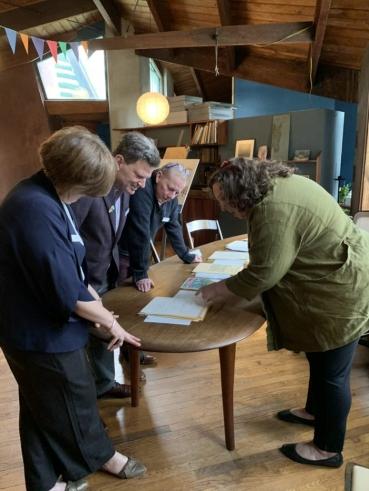
2 minute read
Wharton Esherick Museum
WHARTON ESHERICK MUSEUM by Katie Wynne (she/her/hers), Communications and Public Programs Director Discoveries in the Wharton Esherick Museum Archives
In spring 2021, WEM staff were excited to discover a cache of archival materials tucked away in Esherick's 1956 Workshop building. Among the materials were Esherick client files, correspondence, photographs, ephemera, and personal objects. “We've only scratched the surface of what these new archives mean and the stories they can tell us,” reflects Emily Zilber, WEM Director of Curatorial Affairs and Strategic Partnerships. “Our uncovering of this material allows for a richer understanding of the processes, relationships, and influences that shaped Esherick's artistic path, and adds significantly to the already rich WEM archival collections. We are excited for the possibilities for new scholarship that this material invites.”
Advertisement
While WEM is still in the midst of processing and learning about what these archives contain, we're committed to sharing elements from them that deepen our understanding of Esherick's life, legacy, and impact. Here are just a couple of our favorites: A Sculpture Proposal for the Philadelphia Zoo This brilliantly colored drawing of one of Esherick's monkeys, which visitors to the Studio will be familiar with, accompanies a series of correspondence focused on a proposal to the Zoo Sculpture Committee of the Fairmount Park Art Association from 1959. Esherick shares the kinds of animal sculptures he has made - and could make - with the committee, which did not end up awarding him the commission. Nonetheless, his final suggestion displayed Esherick's trademark sense of fun and irreverence, if not his need for biological accuracy!
Colorful drawing of a proposed sculpture for the Philadelphia Zoo, Wharton Esherick, 1959. Wharton Esherick Museum Collection. Or, to be amusing and abstract, I am wondering what kind of figure I would or could create if a giraffe mated with a hippopotamus - the offspring of such a union. What say?
Even though Esherick wasn't selected, the committee tried to soften the blow by reminding Esherick of how busy he was with other clients and of his strength as an artist.
Client Conundrums Esherick's personality and openness with clients is also apparent through a series of correspondence from 1962 and 1963 with a client named Bill Huggler, who owned a Paoli Insurance Agency. Their back and forth regarding payment on an end table and the refinishing of a cocktail table not only includes Esherick asking for payment to be rendered before he goes to the hospital, since it would “…help to have this,” but also Esherick hand-writing on a 1962 invoice letter “Now! Now! Big Boy!”
This humorous interjection on an otherwise formal letter gives a sense of what the relationship between the two men might have been like. Huggler also replies with similar cheekiness in his letters to Esherick, pointedly noting, “I must have been drunk to have paid so much for repairs, namely 45. You owe me a table or something.”
These are just two stories, but there are so many more to uncover. If you're a student or scholar interested in learning more about WEM's archives, please connect with Emily Zilber at emily@whartonesherickmuseum.org. We are happy to support research requests as we can accommodate them, and love to see that work out in the world.
The Wharton Esherick Museum is experienced through guided tours that must be reserved in advance. To learn more visit www.whartonesherickmuseum.org.


